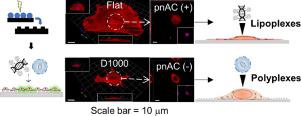Acta Biomaterialia ( IF 9.7 ) Pub Date : 2020-05-19 , DOI: 10.1016/j.actbio.2020.05.015 Ray Chang,Qingfeng Yan,Peter Kingshott,Wei-Bor Tsai,Peng-Yuan Wang

|
Gene transfection is important in biotechnology and is used to modify cells intrinsically. It can be conducted in cell suspension or after cell adhesion, where the efficiency is dependent on many factors such as the type of nanocarrier used and cell division processes. Anchor-dependent cells are sensitive to the substrate they are attached to and adapt their behavior accordingly, including plasmid trafficking during gene transfection. Previously, it was shown in our group that the cytoskeleton is an essential factor in influencing gene transfection in skeletal myoblasts using nanogrooves as a substrate. In this study, the effect of the cytoskeleton on gene transfection efficiency of skeletal myoblasts was studied using various nanopillars and nanocarriers. Nanopillars with different diameters (200-1000 nm) and depths (200 or 400 nm) were fabricated using colloidal self-assembly and reactive ion etching. All surfaces were treated with oxygen plasma or polydopamine (PD) to further control cell morphology. Plasmid DNA was delivered into cells using jetPRIME or Lipofectamine 3000 nanocarriers. After screening hundreds of images, two distinguishable F-actin distributions were found, i.e., cells with or without a perinuclear actin cap (pnAC). Cells attached to nanopillars, especially the deep pillars, had a smaller spreading area, shorter F-actin, more 3D-like cell nuclei, and a lower percentage of pnAC, which lead to a higher gene transfection efficiency using jetPRIME. On the other hand, cells attached to the shallow nanopillars or flat surfaces had a larger spreading area, longer F-actin, more 2D-like cell nuclei, and a higher percentage of pnAC that facilitates gene transfection using Lipofectamine. The effects of cell density, cytoskeleton (cytoD), and focal adhesions (RGD) on gene transfection were also studied, and the results were consistent with our hypothesis that F-actin distribution is one of the critical factors in gene transfection. In conclusion, pnAC plays a vital role in the intracellular trafficking of nanocarrier/plasmid complexes and this study provides new insights into gene transfection in anchor-dependent cells.
Statement of Significance
This study provides a new perspective in gene transfection using attached cells where perinuclear actin cap (pnAC) is an essential factor involved in transfection efficiency. A series of nanopillars were used to harness cell and cytoskeleton morphology. Two distinguishable cytoskeletal structures were found including cells with or without pnAC. 2D-like cells with pnAC facilitate gene delivery using liposome-based nanocarriers, while 3D-like cells without pnAC benefit gene delivery using cationic polymer-based nanocarriers. This study reveals the importance of the cytoskeleton during gene transfection that is beneficial in tissue transfection.
中文翻译:

利用核柱周围肌动蛋白帽(pnAC)影响纳米载体在骨骼成肌细胞中的纳米载体运输和基因转染效率。
基因转染在生物技术中很重要,并用于本质上修饰细胞。它可以在细胞悬浮液中或细胞粘附后进行,其中效率取决于许多因素,例如所用纳米载体的类型和细胞分裂过程。锚依赖性细胞对它们附着的底物敏感,并据此适应其行为,包括基因转染过程中的质粒运输。以前,在我们的研究组中表明,细胞骨架是影响使用纳米槽作为基质的成肌细胞基因转染的重要因素。在这项研究中,使用各种纳米柱和纳米载体研究了细胞骨架对骨骼成肌细胞基因转染效率的影响。使用胶体自组装和反应性离子刻蚀制造了具有不同直径(200-1000 nm)和深度(200或400 nm)的纳米柱。所有表面均用氧等离子体或聚多巴胺(PD)处理,以进一步控制细胞形态。使用jetPRIME或Lipofectamine 3000纳米载体将质粒DNA递送到细胞中。在筛选了数百张图像后,发现了两个可区分的F-肌动蛋白分布,即带有或不带有核周肌动蛋白帽(pnAC)的细胞。附着在纳米柱上的细胞,尤其是深支柱,具有较小的扩散区域,较短的F-肌动蛋白,更多的3D样细胞核和较低的pnAC百分比,这导致使用jetPRIME的基因转染效率更高。另一方面,附着在浅纳米柱或平坦表面上的细胞散布面积更大,F-肌动蛋白更长,更多2D样细胞核,以及更高百分比的pnAC,可促进使用Lipofectamine进行基因转染。还研究了细胞密度,细胞骨架(cytoD)和黏着斑(RGD)对基因转染的影响,结果与我们的假设F-肌动蛋白分布是基因转染的关键因素之一相一致。总之,pnAC在细胞内纳米载体/质粒复合物的运输中起着至关重要的作用,这项研究为锚定依赖性细胞中的基因转染提供了新的见解。结果与我们的假设一致,即F-肌动蛋白的分布是基因转染的关键因素之一。总之,pnAC在细胞内纳米载体/质粒复合物的运输中起着至关重要的作用,这项研究为锚定依赖性细胞中的基因转染提供了新的见解。结果与我们的假设一致,即F-肌动蛋白分布是基因转染的关键因素之一。总之,pnAC在细胞内纳米载体/质粒复合物的运输中起着至关重要的作用,这项研究为锚定依赖性细胞的基因转染提供了新的见识。
重要声明
这项研究为使用贴壁细胞进行基因转染提供了新的视角,其中核周肌动蛋白帽(pnAC)是影响转染效率的重要因素。一系列纳米柱被用来利用细胞和细胞骨架的形态。发现了两个可区分的细胞骨架结构,包括有或没有pnAC的细胞。具有pnAC的2D样细胞有助于使用基于脂质体的纳米载体进行基因递送,而没有pnAC的3D样细胞则有利于使用基于阳离子聚合物的纳米载体进行基因递送。这项研究揭示了基因转染过程中细胞骨架的重要性,这对组织转染是有益的。


























 京公网安备 11010802027423号
京公网安备 11010802027423号